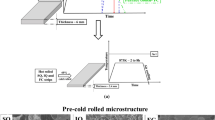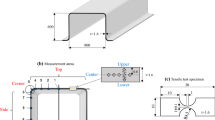Abstract
The hydrogen embrittlement (HE) characteristics of the low carbon steels: Fe-xC-1.5Mn-0.03Si (0.05C, 0.1C, and 0.15C) with ultimate tensile strength (UTS) of ~ 1200 MPa, were examined experimentally after heating and surface treatment processes. For this investigation, the low carbon steels with different microstructural characteristics, including phase structures, precipitates, and internal strain, were employed. The high internal strain was seen in the Fe-0.15C steels after cold rolling (CR), water quenching (WQ), and bake hardening (BH) process, while the low strain was obtained in the steel samples after the annealing process. The high strain for CR and WQ (and BH) is caused by severe plastic deformation and the phase transformation of the martensite structure, respectively. Carbide particles were precipitated in the WQ and BH samples, and the amount of carbide was correlated with their carbon content. HE occurred only in the CR-0.15C and WQ-0.15C samples although the low UTS of ~ 1200 MPa was used, where the fracture strain decreased significantly. HE was attributed to the high internal strain and high carbon content which led to the hydrogen trapping site. A multiple regression analysis was also carried out to estimate the extent of HE of the low carbon steels.









Similar content being viewed by others
References
Momotani Y, Shibata A, Daisuke Terada N, and Tsuji, Int. J. Hydrogen Energy 42 (2017) 3371.
Shibata A, Yonemura T, Momotani Y, Park M-H, Takagi S, Madi Y, Besson J, and Tsuji N, Acta Mater. 210 (2021) 116828
Nagao A, Hayashi K, Oi K, and Mitao S, ISIJ Int. 52 (2012) 213.
Okayasu M, and Fujiwara T, Int. J. Hydrogen Energy 46 (2021) 19657.
Dayal R K, and Parvathavarthini N, Sâdhanâ 28 (2003) 431.
Lee S-J, Ronevich J A, Krauss G, and Matlock D, ISIJ Int. 50 (2010) 294.
Barannikovaa S A, Kosinovc D A, Zueva L B, Gromovc V E, and Konovalov S V,Steel in Translation 46 (2016) 851.
Louthan M R Jr, J. Fail. Anal. Preven. 8 (2008) 289.
Chan S L I, and Charles J A, Mater. Sci. Technol. 2 (1986) 956.
Murakami Y, Kanezaki T, and Sofronis P, Eng. Fract. Mech. 97 (2013) 227.
Baker L J, Daniel S R, and Parker J D, Mater. Sci. Tech. 18 (2002) 355.
Okayasu M, Arai R, and Senuma T, Int. J. Fract. 231 (2021) 257.
Author information
Authors and Affiliations
Corresponding author
Ethics declarations
Conflict of interest
The authors declare no conflict of interest.
Additional information
Publisher's Note
Springer Nature remains neutral with regard to jurisdictional claims in published maps and institutional affiliations.
Rights and permissions
Springer Nature or its licensor (e.g. a society or other partner) holds exclusive rights to this article under a publishing agreement with the author(s) or other rightsholder(s); author self-archiving of the accepted manuscript version of this article is solely governed by the terms of such publishing agreement and applicable law.
About this article
Cite this article
Okayasu, M., Kokado, T. Hydrogen Embrittlement Characteristics of Low Carbon Steels After Heat and Surface Treatments. Trans Indian Inst Met (2024). https://doi.org/10.1007/s12666-024-03288-x
Received:
Accepted:
Published:
DOI: https://doi.org/10.1007/s12666-024-03288-x




